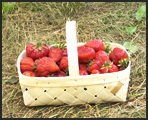
It is nearly July- it is hard to believe… strawberries have ripened early, lemon daylilies are in bloom!

It is nearly July- it is hard to believe… strawberries have ripened early, lemon daylilies are in bloom!
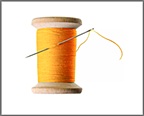
The French hot air balloon fabric was the fabric of the week!
Continue reading Hot Air Balloon- Fabric of the Week – 21 June 2013
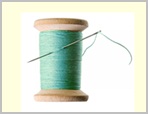
Two new retro fabrics have been listed!
This week we have quite a few new fabrics to list.
The first two are patterns with a reto or modern look to them.
Continue reading Retro Modern Fabric- new listings – 20 June 2013
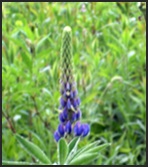
When the lupin bloom in Maine, one knows it is summer! They came into season very early this year…

One of the most prominent flowers seen in Maine, is lupin. It holds a place dear to Mainers and visitors alike… it says summer in Maine.
In June fields and roadsides are blanketed with the purple, pink, and cream flower spi kes of lupin. They are striking close up, and form soft drifts of color in the landscape. They are a marking point in Maine’s yearly cycle. When the lupin are in bloom, it is summer.
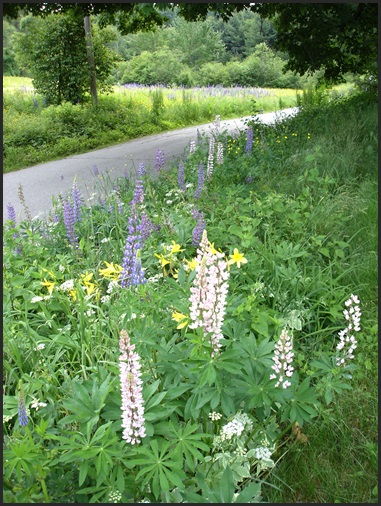
Known here as roadside lupin,
its Latin name is Lupinus polyphyllus.
At this time of year one sees cars screeching to a halt along the side of the road, narrowly avoiding a rear end collision. A person leaps out, and grabs a shovel, and starts hacking away at the ground to take plants home. This is a futile effort to get the plant to ones garden.
If a large full grown plant is blooming, it can NOT be moved! Lupin are deeply tap rooted. Small seedlings can be moved, large blooming lupin plants from Maine can not.
The lupin one sees in such profusion are not native to Maine. The native species is Lupinus perennis, and has not been documented within the state in years.
A few years ago Acadia National Park on Mt. Desert Island wanted to eradicate them from the park, as they are not indiginous. The outcry was immense! The lupin stayed.
The roadside lupin grows from 24″ – 40″ tall. It has distinctive palmate leaves. It is a legume, and the flowers have a typical bean or pea flower with the top petals called standards, two lateral wings and a keel, which is the two lowest petals that are fused together. The flowers can be a single color or bicolor. The flowers can be shades of purple, blue, pink, violet, and white. If one sees a yellow lupin it is probably a Russel hybrid that has escaped from a garden.
In May one sees the first evidence of the lupin flowers to come.
Clumps of leaves protruding from grass along the roads and in fields are seen.
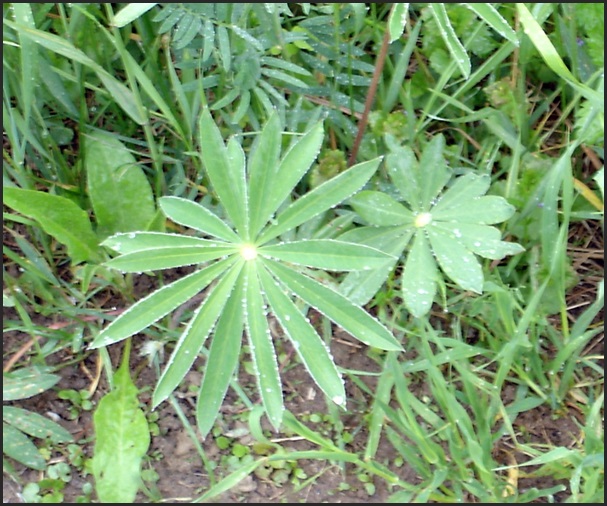
The palmate leaves are very distinctive.
And rimmed with dew in the early morning, or holding a drop of water from rain,
are lovely in their own right.
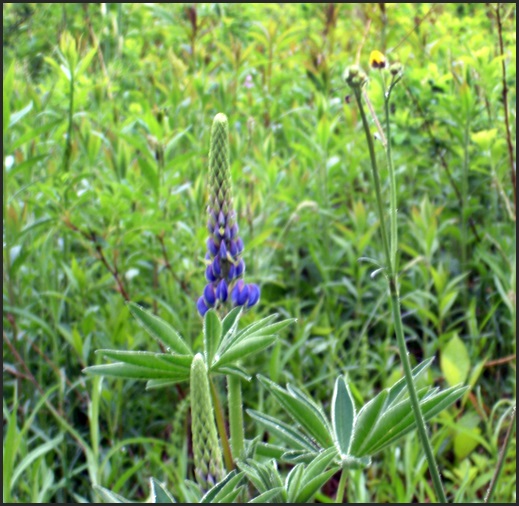
The stems arise with flowers tightly packed along the stock.
They open from the bottom.
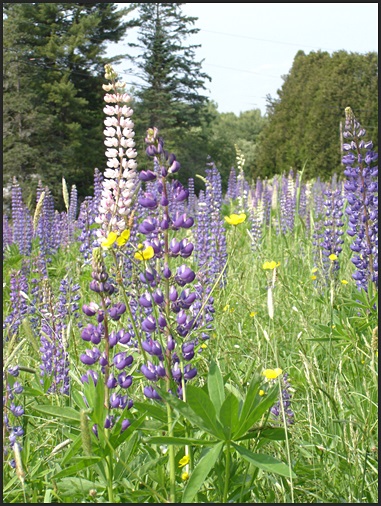
The flower stock elongates as the flower open.
It is then that the two toned effect of the flowers
becomes evident.
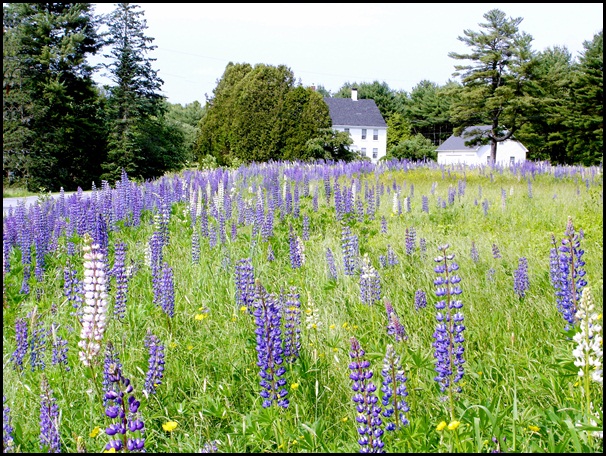
A field of lupin, in full bloom,
dances in the wind.
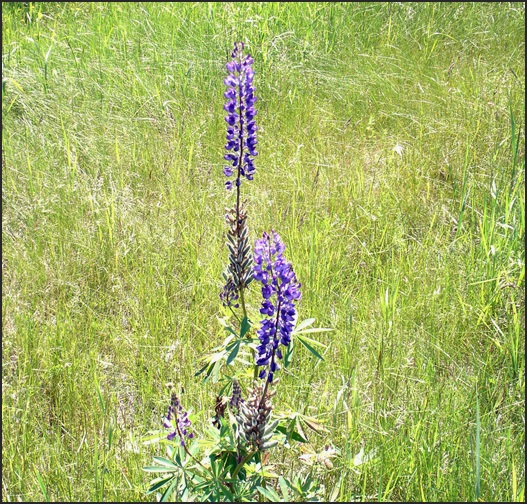
A lupin plant, with the last of its initial flowering stalk still blooming,
will start forming seeds pods, as new lateral stalks are formed.
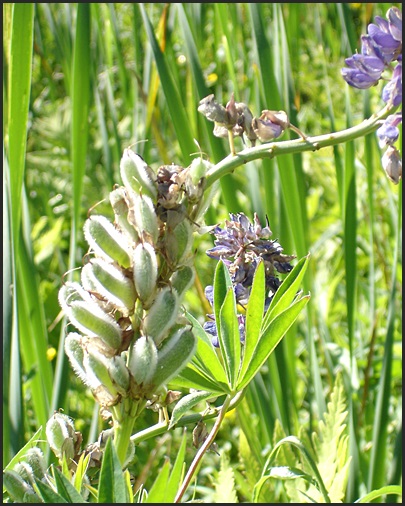
The seed pods are fuzzy,
which helps them shed moisture as the seed pods mature,
lessening the probability of rotting.
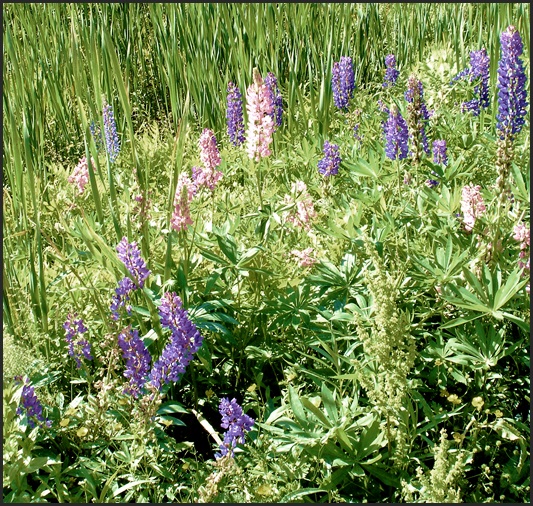
The lupin blooms for a good three weeks.
As the lupin matures,
the surrounding grasses and other plants have also been growing.
The elongation of the stems as the flowers open,
keeps the flowers
above the surrounding grasses and other plants,
which means they continue to add color to in a field or in a bed of other maturing plants.
__________
So, how does one move Maine lupin? One can move small plants. But, before digging them out of the landscape willy nilly- be prepared. Bring a proper box, foil, paper towel, and water. One wants to wrap the root ball in a wet paper towel, and either pack them closely together in a box, or wrap the moist paper covered roots in foil.
The other way is simpler. The first is just to remove full formed seed pods, gently, from the flower stem, place them in a paper bag, and take them home. Place them where you want plants. The pods will finish drying, and crack open, spilling the seed.
If you decide to cut a full stalk with seeds, please only take one per plant, so they will reseed the area you are taking them from. The plants need to go to seed to keep them in the landscape. Here, the sides of roads are not mowed until the pods are dried, so that the lupin keeps regenerating.
One thing to remember… if you have one lupin plant, within a few years you will have many- so when harvesting the flower stalks for seeds, keep that in mind.
Lupin do have one negative attribute. They are aphid magnets. They will be covered with them during the flowering season. So, keep them separate from delicate plants that can not survive a massive attach of them.
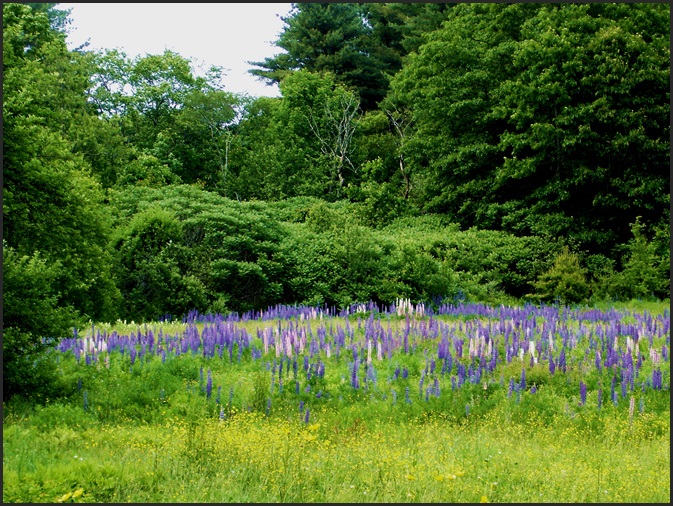
A field of lupin
has the effect is that of a Monet painting.
__________________________________
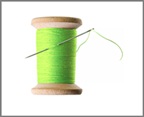
The ombred blue starfish fabric is back in stock!
Continue reading Starfish Fabric- back in stock! – 12 June 2013

Schumacher Oriental Fabric, a black toile chinoserie, has just been listed.
Continue reading Schumacher Oriental Fabric Just Listed – 10 June 2013
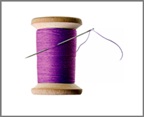
Just listed destash pieces: coastal shell fabric pieces, a horse fabric piece, and a Marilyn Monroe fabric.
Continue reading Seashell Fabric, Equestrian Fabric, and other destash pieces – 06 June 2013

New seahorse fabric and seashell fabrics have arrived!
Continue reading Seahorse Seashell Fabric- NEW – 04 June 2013

An equestrian fabric, with a horse hunt theme that is a bit different has come in.
Continue reading Equestrian horse fabric- newly listed – 03 June 2013